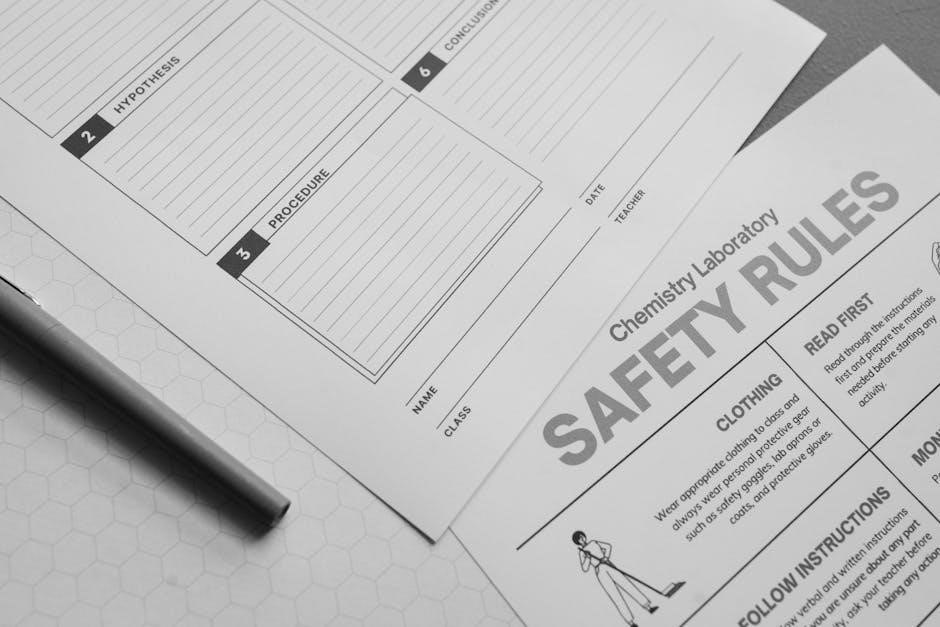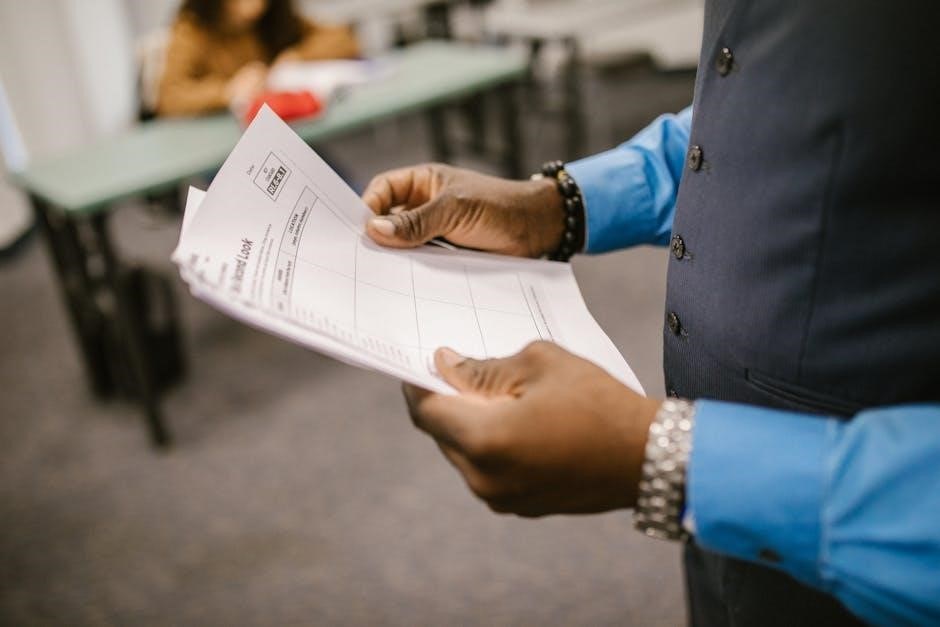
Welcome to our guide on LCM and GCF worksheets! These essential tools help students master least common multiples and greatest common factors through interactive exercises and real-world applications. Perfect for classroom or independent learning, LCM and GCF worksheets simplify complex concepts, making math more approachable and fun. Whether you’re a teacher or a student, these resources are designed to enhance understanding and improve problem-solving skills. Available in convenient PDF formats, they offer a structured approach to practicing these fundamental mathematical concepts. Start your learning journey today and explore the world of LCM and GCF with ease!
What Are LCM and GCF?
LCM (Least Common Multiple) is the smallest number that is a multiple of two or more numbers, while GCF (Greatest Common Factor) is the largest number that divides two or more numbers without a remainder. Both concepts are fundamental in simplifying fractions, solving equations, and understanding number relationships; They are essential tools in mathematics, helping with tasks like dividing objects equally or scheduling events. Mastering LCM and GCF enhances problem-solving skills and mathematical fluency.
Importance of LCM and GCF in Mathematics
LCM and GCF are foundational concepts in mathematics, essential for simplifying fractions, solving equations, and understanding number relationships; They play a crucial role in various mathematical operations, such as scaling recipes, scheduling events, and dividing objects equally. These concepts also form the basis for more advanced topics like algebra, geometry, and data analysis. Proficiency in LCM and GCF enhances problem-solving skills, promoting mathematical fluency and logical thinking.

Benefits of Using LCM and GCF Worksheets
LCM and GCF worksheets enhance problem-solving skills, improve conceptual understanding, and provide structured practice. They help students master these concepts through engaging exercises, fostering mathematical confidence and fluency.
Enhancing Problem-Solving Skills
Engaging with LCM and GCF worksheets sharpens critical thinking and analytical abilities. By solving various problems, students develop logical reasoning and learn to approach mathematical challenges systematically. These exercises train the mind to break down complex problems into manageable steps, fostering a deeper understanding of number relationships and their practical applications in real-world scenarios. Regular practice through these worksheets builds confidence and enhances overall mathematical proficiency.
Improving Conceptual Understanding
LCM and GCF worksheets are designed to clarify complex mathematical concepts by breaking them into manageable parts. Through structured exercises, students gain a deeper grasp of factors, multiples, and their relationships. These worksheets often include visual aids like charts and diagrams, helping learners visualize how numbers interact. By focusing on foundational principles, they build a solid understanding of LCM and GCF, which is essential for tackling more advanced mathematical challenges with confidence.
Developing Computational Fluency
LCM and GCF worksheets enhance computational fluency by providing repeated practice in calculating multiples and factors. These exercises train students to perform accurate and efficient calculations, reinforcing number sense and arithmetic skills. With each problem solved, learners develop speed and precision, essential for tackling complex mathematical operations. Regular practice through these worksheets builds proficiency, enabling students to approach higher-level math with confidence and readiness.
Preparation for Advanced Mathematics
Mastering LCM and GCF through worksheets prepares students for advanced mathematics by building a strong foundation in number theory and algebra. These concepts are crucial for simplifying expressions, solving equations, and understanding more complex topics like geometry and data analysis. Regular practice with LCM and GCF problems ensures fluency and readiness for higher-level math, making transitions to advanced studies smoother and more manageable.

How to Find LCM and GCF
LCM and GCF can be found using prime factorization, listing multiples or factors, or the division method. These techniques help identify commonalities and multiples efficiently.
Prime Factorization Method
The prime factorization method involves breaking down numbers into their prime factors. For GCF, identify and multiply the common prime factors. For LCM, take the highest power of all prime factors and multiply them. This method ensures accuracy and clarity in finding LCM and GCF. It is a foundational technique that builds a strong understanding of number relationships, making it easier to solve complex problems in mathematics. Regular practice with worksheets can enhance proficiency in this method.
Listing Multiples and Factors
Listing multiples and factors is a straightforward method for finding LCM and GCF. For LCM, list the multiples of each number until a common multiple is found. For GCF, list all factors of each number and identify the highest common factor. This visual approach is helpful for smaller numbers and provides clear confirmation of results. It’s a reliable technique for understanding the relationship between multiples and factors, making it easier to grasp these concepts effectively.
Using Division Method
The division method is an efficient way to find GCF and LCM. For GCF, divide the larger number by the smaller, replace the larger number with the smaller, and repeat with the remainder until the remainder is zero. The last non-zero remainder is the GCF. For LCM, use the formula: LCM(a, b) = (a × b) / GCF(a, b). This method minimizes listing multiples or factors, making it a time-saving approach for quick calculations and enhanced understanding.
Applications in Real-World Scenarios
LCM and GCF are essential in real-world situations like scheduling, music, and construction. For example, LCM helps determine the next meeting time of two events occurring at different intervals, while GCF simplifies dividing materials evenly. These concepts are also used in cooking to scale recipes and in music to synchronize beats. Practicing with worksheets ensures students can apply these skills to practical problems, making math relevant and useful in everyday life.

Practice Problems and Exercises
Engage with a variety of LCM and GCF exercises, from basic number problems to complex word scenarios. These exercises help build confidence and mastery of the concepts, ensuring a solid foundation for advanced math topics. With clear instructions and adaptable difficulty levels, these practice sets are ideal for both students and educators seeking to reinforce learning through hands-on experience. Available in PDF formats, they offer convenience and accessibility for anytime, anywhere practice.
Basic LCM and GCF Problems
Start with simple numerical exercises to grasp the fundamentals of LCM and GCF. These problems involve finding the least common multiple or greatest common factor of small sets of numbers. Begin with pairs of numbers, then progress to lists of three or more. Practice identifying prime factors, listing multiples, and applying division methods. Regular drills improve computational fluency and understanding of divisibility. These foundational exercises build confidence and prepare students for more complex challenges, ensuring a strong grasp of the concepts.
Word Problems Involving LCM and GCF
Apply LCM and GCF concepts to real-world scenarios through engaging word problems. For example, determine the least common multiple to schedule recurring events or find the greatest common factor to divide objects evenly. These problems enhance problem-solving skills by requiring students to interpret contexts, identify relevant numbers, and apply appropriate methods. Practical examples include dividing cookies into equal containers or timing periodic tasks, making math relatable and fun while improving conceptual understanding.
Multiple-Step Problems
Engage with complex scenarios by solving multiple-step LCM and GCF problems. These challenges require students to apply their understanding in layered contexts, such as scheduling events or combining tasks. For instance, determining the least common multiple of multiple numbers and then using it to solve a real-world application. These problems enhance critical thinking and problem-solving skills, as they often involve combining LCM and GCF concepts in sequential steps to reach a final solution.
Interactive and Engaging Activities
Make learning LCM and GCF fun with interactive activities! Quizzes, puzzles, and games challenge students to apply their skills creatively. Real-world applications, such as scheduling events or dividing resources, bring concepts to life. Students can also create their own word problems or participate in group competitions to solve LCM and GCF challenges. These activities foster collaboration, critical thinking, and a deeper understanding of mathematical relationships while keeping the learning process enjoyable and dynamic.

Tips for Effective Practice
- Focus on understanding core concepts before solving problems.
- Use visual aids like factor trees or Venn diagrams.
- Practice regularly to build computational fluency.
- Review mistakes to identify and correct errors.
Understanding the Concepts
Mastering LCM (Least Common Multiple) and GCF (Greatest Common Factor) requires a solid grasp of their definitions and applications. LCM is the smallest number that is a multiple of two or more numbers, while GCF is the largest number that divides them without leaving a remainder. Begin by understanding prime factorization, a key method for finding both. Break numbers into their prime components to identify common factors for GCF and the highest powers for LCM. This foundation is essential for solving problems accurately. Start with simple numbers, then progress to more complex sets. Regular practice with worksheets will build confidence and fluency in these skills, preparing you for advanced mathematical concepts like algebra and data analysis. Use visual aids like factor trees or Venn diagrams to make the process clearer and more engaging. Always review mistakes to understand where errors occur and how to avoid them in the future. With consistent effort, you’ll master LCM and GCF, enhancing your overall mathematical proficiency. PDF worksheets are an excellent resource for structured practice, offering a variety of problems to suit different skill levels. By focusing on understanding rather than memorization, you’ll develop a deeper appreciation for these fundamental concepts and their real-world applications. Remember, practice is key to long-term mastery, so dedicate time each day to work through problems and review your progress. Over time, these concepts will become second nature, allowing you to approach more challenging mathematical topics with confidence. The more you practice, the more comfortable you’ll become with identifying patterns and relationships between numbers, which is crucial for success in higher-level math. Keep your worksheets organized and track your improvement to stay motivated and engaged in the learning process. Celebrate small victories along the way, and don’t hesitate to seek help when needed. With persistence and the right resources, you’ll achieve mastery of LCM and GCF, unlocking a stronger foundation in mathematics.
Using Visual Aids
Visual aids like factor trees, Venn diagrams, and number lines are invaluable for understanding LCM and GCF. These tools help break down complex concepts into clear, visual representations. Factor trees, for instance, illustrate prime factorization, making it easier to identify common factors for GCF. Venn diagrams highlight shared and unique factors, simplifying the process of finding GCF and LCM. Incorporating these aids into your study routine enhances comprehension and retention, making problem-solving more intuitive and enjoyable. They are particularly effective for visual learners, providing a concrete way to grasp abstract mathematical relationships. By using visual aids, you can explore real-world applications, such as scheduling or resource allocation, where LCM and GCF are essential. These resources are often included in PDF worksheets, offering a structured way to practice and apply these methods. Over time, visual aids will help you develop a deeper understanding of how numbers relate, making you more proficient in solving LCM and GCF problems with confidence and accuracy.
Regular Practice
Regular practice is key to mastering LCM and GCF concepts. Consistent exercise helps build confidence and reduces errors over time. By solving problems regularly, students develop a deeper understanding of how to apply these concepts in real-world scenarios, such as scheduling or resource allocation. Utilize LCM and GCF worksheet PDFs to create a structured practice routine, ensuring steady progress and improved problem-solving skills. Regular practice fosters long-term retention and fluency in mathematical reasoning.
Seeking Feedback
Seeking feedback is a vital part of mastering LCM and GCF concepts. After completing worksheets, students should review their work with teachers, peers, or tutors to identify mistakes and improve accuracy. Feedback provides clarity on common errors and reinforces understanding. Regularly discussing results helps refine problem-solving techniques and builds confidence. Constructive criticism is essential for growth, ensuring students grasp foundational math skills effectively. Timely feedback fosters a deeper understanding of LCM and GCF principles, leading to long-term success.

Resources for LCM and GCF Worksheets
Access a variety of LCM and GCF worksheet resources online, including PDF downloads, mobile apps, and textbook materials. Websites like CK-12 and educational platforms offer free, printable worksheets tailored for different skill levels, ensuring comprehensive practice and understanding of these mathematical concepts.
Recommended Websites
Explore reputable websites offering LCM and GCF worksheet PDFs. Platforms like CK-12 Foundation provide free, downloadable resources tailored for various grade levels. Khan Academy and Math Worksheets Land also offer comprehensive worksheets with detailed solutions. For interactive learning, Education.com features a wide range of LCM and GCF exercises. These websites ensure accessible and high-quality materials for effective practice and mastery of these mathematical concepts.
PDF Worksheets
PDF worksheets are an excellent resource for practicing LCM and GCF problems. They are widely available online, offering comprehensive exercises tailored to various skill levels. Many websites, such as CK-12 Foundation and Math Worksheets Land, provide free downloadable PDFs with step-by-step solutions. These worksheets are ideal for self-study or classroom use, featuring clear instructions and ample practice problems. They also include word problems and multiple-step exercises to enhance understanding and application of LCM and GCF concepts.
Mobile Applications
Mobile applications like Photomath, Khan Academy, and Mathway offer interactive tools for practicing LCM and GCF problems. These apps provide real-time feedback, step-by-step solutions, and personalized learning paths. They are ideal for on-the-go learning, allowing students to master mathematical concepts anytime, anywhere. With engaging interfaces and comprehensive resources, these apps make learning LCM and GCF fun and accessible, ensuring a strong foundation in these essential math skills.
Textbook Resources
Textbooks from reputable publishers like CK-12 Foundation and National Council of Teachers of Mathematics provide comprehensive worksheets for LCM and GCF. These resources are designed to align with educational standards, offering clear instructions and varied problem sets. Many textbooks include both basic and advanced exercises, making them suitable for diverse learning needs. They are invaluable tools for teachers and students, supporting structured learning and mastery of these essential mathematical concepts.

Advanced Applications
LCM and GCF are foundational in algebra, geometry, and data analysis. They simplify complex calculations, enabling advancements in number theory, cryptography, and scientific computations. Essential skills for higher math!

LCM and GCF in Algebra
LCM and GCF are essential in algebra for simplifying expressions and solving equations. They help reduce polynomials, solve systems of equations, and factor expressions efficiently. For example, finding the LCM of denominators aids in combining fractions, while GCF simplifies factoring. These concepts are crucial for advanced algebraic manipulations and problem-solving, preparing students for higher-level mathematics. Mastering LCM and GCF enhances algebraic thinking and application in various mathematical contexts.
Use in Geometry and Trigonometry
LCM and GCF are valuable in geometry and trigonometry for solving problems involving angles, side lengths, and wave patterns. They aid in calculating common units for constructions and simplifying trigonometric expressions. For example, finding the GCF of polygon sides helps in creating similar triangles, while LCM assists in aligning periodic functions like sine and cosine. These tools enhance problem-solving skills and provide a stronger foundation for understanding geometric principles and trigonometric identities.
Applications in Data Analysis
LCM and GCF are beneficial in data analysis for organizing and interpreting datasets. They help in identifying common intervals for data points, enabling the creation of aligned graphs and schedules. For instance, LCM can determine the best intervals for histograms, while GCF simplifies data groupings. These methods enhance data interpretation and improve analysis efficiency, making them valuable tools for understanding patterns in real-world datasets and applications like market trends or resource distribution.
Role in Number Theory
LCM and GCF are foundational concepts in number theory, serving as essential tools for understanding the relationships between integers. They help in simplifying fractions, factoring numbers, and identifying periodic patterns in modular arithmetic. LCM determines the smallest common multiple of numbers, while GCF identifies their largest shared divisor. These principles are vital for advanced theoretical mathematics, providing a framework for analyzing and solving complex numerical problems efficiently.

Common Mistakes
Common errors include incorrect prime factorization, miscounting multiples or factors, and applying wrong division methods. Students often mix up LCM and GCF concepts in word problems.
Errors in Prime Factorization
Common errors in prime factorization include incorrect breakdown of numbers, missing prime factors, or miscalculations. These mistakes often lead to wrong GCF or LCM results. For example, failing to identify all prime factors can result in an inaccurate GCF, while incorrect multiplication of primes can lead to an erroneous LCM. Proper prime factorization is essential to avoid these errors and ensure accurate calculations in both concepts. Always double-check your factorization to maintain precision.
Miscounting Multiples and Factors
Miscounting multiples and factors is a common error when determining LCM and GCF. For example, missing a multiple of a number or incorrectly listing factors can lead to incorrect results. To avoid this, ensure accurate listing of multiples and factors before proceeding with calculations. Double-checking your work or using alternative methods, like prime factorization, can help prevent such errors and ensure reliable outcomes in both LCM and GCF problems. Attention to detail is key to avoiding these mistakes.
Incorrect Division Techniques
Incorrect division techniques often lead to errors in LCM and GCF calculations. Mistakes like dividing by incorrect numbers or misapplying the division method can result in inaccurate findings. For instance, improperly handling remainders or failing to organize divisions systematically can disrupt the process. Always ensure precise division steps and verify results to avoid such pitfalls; Practicing proper division methods enhances accuracy and mastery of LCM and GCF problems.
Interpreting Word Problems
Interpreting word problems involving LCM and GCF can be challenging due to unclear language or misidentifying the required operation. Students often struggle to determine whether the problem demands finding the LCM or GCF. Common errors include misreading the context or failing to extract relevant numbers. To improve, carefully read the problem, identify key terms, and break it into manageable parts. Practicing with word problems in LCM and GCF worksheets helps build confidence and accuracy in real-world applications.

Mastering LCM and GCF through worksheets empowers students with essential math skills, enhancing problem-solving abilities and real-world application confidence. Consistent practice fosters long-term understanding and proficiency.
LCM and GCF worksheets are invaluable tools for mastering essential mathematical concepts. They help students understand prime factorization, listing multiples, and division methods. Regular practice with these worksheets enhances problem-solving skills, improves conceptual clarity, and builds computational fluency. By addressing real-world applications and advanced math preparation, LCM and GCF worksheets provide a comprehensive learning experience. They are ideal for both classroom instruction and independent study, ensuring a strong foundation in number theory and algebra.
Encouragement for Continued Practice
Consistent practice with LCM and GCF worksheets is key to mastering these concepts. Regular exercises build confidence and fluency in mathematical problem-solving. Encourage students to explore various resources, such as PDF worksheets and interactive tools, to stay engaged. Celebrate progress, no matter how small, to foster a positive learning environment. Remind learners that persistence and dedication will lead to long-term success in mathematics and beyond.
Final Thoughts on Mastery
Mastery of LCM and GCF requires consistent practice and a deep understanding of underlying principles. By leveraging worksheet resources, students can systematically build proficiency, ensuring these concepts become second nature. Embrace challenges, celebrate small victories, and recognize the long-term value of these skills in advanced mathematics. With dedication and the right tools, achieving mastery is not only possible but also deeply rewarding.